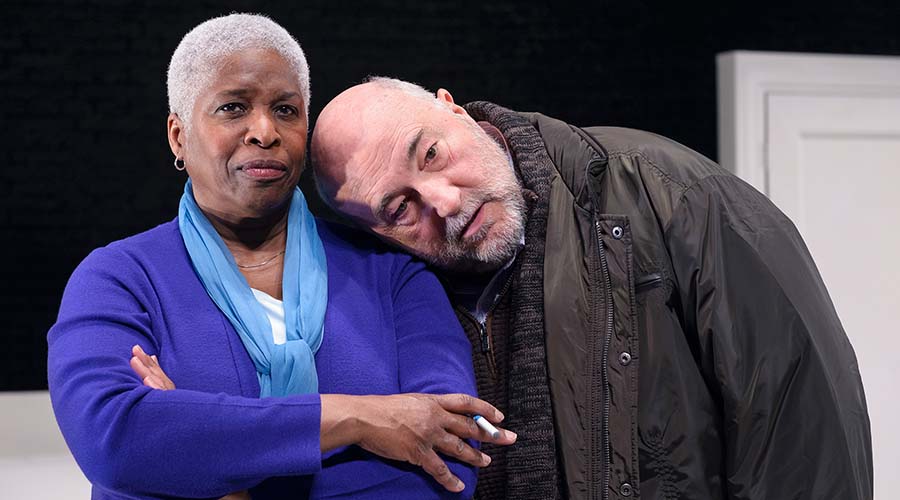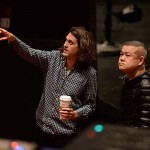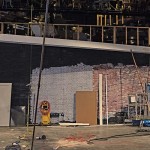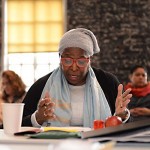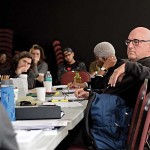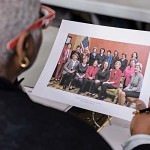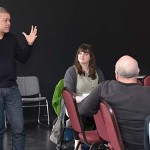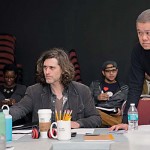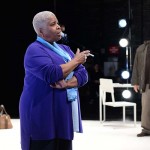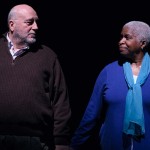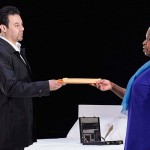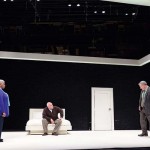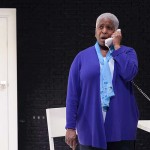Before the baptism-by-balloons in Philadelphia that anointed her as the first female presidential candidate of a major U.S. political party, even before the drawn-out investigations of Benghazi and the emails, there was the Hillary Clinton who desperately needed to win the 2008 New Hampshire primary in order to fend off “The Other Guy.”
The Other Guy is younger and more charismatic—or perhaps “charisma” is simply assumed for younger guys compared to older, more guarded women. Particularly when that guarded woman has long struggled in the shadow of her loquacious and powerful spouse. Perhaps because that loquacious and powerful spouse, with his well-publicized infidelities, is the one who put her on guard in the first place.
Obviously that Hillary—the one who ran her heart out in the 2008 presidential primaries and still lost her party’s nomination—inspired Lucas Hnath’s Hillary and Clinton, which had its world premiere April 1-May 1 at Chicago’s Victory Gardens Theater. But don’t bet on Hnath coming right out and saying it.
The disclaimer “A work of total fiction” appears under the title on the script. The prologue, delivered by the character of Hillary, tells us, “The play you’re about to watch appears to take place on this planet Earth, but in actuality, this play is set on a different Earth located billions of light-years away from our own. And while the people who inhabit this other, faraway Earth appear to be the same exact people who inhabit this Earth, they are very slightly different.”
Written before the success of The Christians gave Hnath a national profile, Hillary and Clinton continues the playwright’s tradition of “stereoscopic” theatricality. Stereoscopy is the process by which two photographs of the same object, taken at slightly different angles, are placed side by side, so that, viewed together, they create a three-dimensional image—while also subtly raising the question of whether what you’re seeing is more “real” when viewed this way.
This isn’t the first time Hnath has taken a stereoscopic approach to a famous subject. Past plays have tackled Isaac Newton (Isaac’s Eye), Walt Disney (A Public Reading of an Unproduced Screenplay About the Death of Walt Disney), and Anna Nicole Smith (The Courtship of Anna Nicole Smith). In an interview during the rehearsal process for Hillary and Clinton, Hnath noted, “I’ve always been interested in people whose image has been simplified or oversimplified. I’ve always been curious to see what happens if you take that person and create a few small tensions with the image. It opens it up differently.”
The tensions aren’t that small for the Hillary in his play. In a hotel on the eve of the New Hampshire primary, she’s torn between the demands of Bill and a campaign adviser, Mark, who seems to have been modeled on longtime Clinton pollster and campaign strategist Mark Penn. An offer to drop out in return for the second spot on the Other’s Guy ticket (the name Obama is never used) also tempts her.
Though he says he typically doesn’t remember how his plays originate, Hnath knows he wrote this one in 2008. That’s about all he claims to recall, adding, “I think I do that mentally. I try to remember as little as possible because every time I sit and watch the play, I have to pretend that I have never seen it.”
In a program interview with Isaac Gomez, Victory Gardens’s literary manager and Hillary’s production dramaturg, Hnath described his writing process as “waking up every day, and you type some things for two or three hours, and then every couple months you look at the pile of stuff you have and you notice it tends to gravitate around a common subject or there’s an obsession at the center of it.” That’s how he noticed he was writing “a play about the Clintons that’s not a play about the Clintons”—a response that is almost, well, Clintonian.
Hnath’s play made its way to Victory Gardens and its artistic director, Chay Yew, via one of Yew’s New York theatre connections, who gave him a stack of well-regarded plays they couldn’t find a place for. Yew said that Hillary “really stood out…It was very deft, and had a lot of layers.” In July 2014, Hillary and Clinton was selected for the theatre’s Ignition Festival of New Plays. Yew and Hnath then took Hillary and Clinton to the 2015 Cape Cod Theatre Project , an annual developmental festival in Falmouth, Mass. “It was a great moment to look at rewrites, what needed to be cut,” said Yew, adding, “Lucas is surgical. He’s also like a musical composer. He looks at it like a score.”
At the first read-through in early March—which coincided with both International Women’s Day and the Michigan primary where Clinton challenger Bernie Sanders upended poll predictions to pull off a victory—Yew asked, “What is this play, and what is the outside world?” He added that there is “a dissonance of familiar and unfamiliar” and noted some of the thematic touchstones—mortality and transition, and the search for personal versus professional relevance. Finally, he said, the play is “a portrait of a marriage.”
Hnath listened intently but didn’t offer his own thoughts initially. Perhaps that’s because he made his intentions clear in a performance note at the beginning of the script, saying that while it might be “very tempting to play these characters as imitations of the real deal…Don’t do it! Do not play for easy recognition. Don’t imitate. Don’t even try to cast actors who look like these people.”
That last note was clearly followed at Victory Gardens, where longtime Chicago actor Cheryl Lynn Bruce, who is African-American, played Hillary, and Latino actor Juan Francisco Villa played the Other Guy. And though John Apicella’s Bill and Keith Kupferer’s Mark are both white men, neither bear a resemblance to their namesakes.
Hnath wanted the team to follow that thinking on other levels too. Before rehearsals began, Gomez developed an exhaustive 74-page packet of background material on the “real” Hillary and Bill. (In writing about this play, mental air-quotes seem unavoidable.) Gomez recalled, “Then we go into first rehearsal, and…Lucas sat down and we were looking through the packet together. He—very kindly, of course—said, ‘Okay, everyone, this packet here? I need you to throw it away.’”
At the read-through, Yew also called the cast’s attention to the structure of the dialogue on the page, the “musicality of the piece.”
“When you see an ellipsis, that indicates thinking,” he explained. “No ellipsis means that they say exactly what they feel.” Here Hnath interjected, “Take out the air. If the script doesn’t tell you to take a beat specifically, run right through.”
Hnath later said he likes to begin rehearsal by telling the director, “This is what works about the play and this is what doesn’t work.” For Hillary he created a 10-page, single-spaced document that “breaks down the entire play and every aspect.” One takeaway: “This play can’t sound like ‘The West Wing.’ Nobody can sound that specific about politics.” Another note: “It’s a text that actors can approach as poetry,” a temptation they should resist or the piece will be “dead on arrival.”
Most of Hnath’s work on the play was aimed at distinguishing the “real” from the imagined. In the version of the script presented at the read-through, Hillary watches herself on television at a campaign stop right before the New Hampshire primary; it’s the famous moment where the “real” Hillary teared up (or did she?) in response to a question about how she manages to keep going through all the pressures of the campaign trail. “You know, this is very personal for me. It’s not just political, it’s not just public,” the “real” Hillary responded.
But while the script called for the audience to hear that audio, if not see the image of her crying, by the time of the first preview on March 31, the audio track had been removed from the play. Yew’s choices, too, pushed away from the real. Set designer William Boles noted that the set description in the rehearsal draft calls for “A hotel room. A bed. On the bed, newspapers. A TV. Chairs. Two doors—one to a bathroom, the other to the outside. The set should feel incomplete—a rehearsal set.”
Boles’s final set was stark white and laid on a diagonal, disrupting our usual expectations of a straight-on realistic proscenium staging.
“From the very beginning, Chay was interested in a white space,” explained Boles. “He wanted to push more toward abstraction.” The actors also rolled out the carpet square and moved the door flats into place at the beginning of the show, further emphasizing the artificiality of creating a “private” space in public.
The most constant thread throughout Hillary and Clinton is the question: Who is Hillary? More to the point: How could any woman as scrutinized in a man’s world ever hope to answer that question?
“This play didn’t happen in a vacuum,” Yew said. “Gender politics—what is it to be a woman of a certain age doing what she’s doing? She has to fight with men.” He added, “I realized this play is about the aching need to be No. 1 and to just be seen when you’re always in the shadows. Even Bill, who had a taste of it—he’s no longer in the limelight. What is this thing called ‘achievement’?”
Not even the Other Guy, who seems to have a political Midas touch, escapes the existential quandary of private life lived in public. In a late-night visit to Hillary after her “tearing up” moment is presumed to have momentarily saved her campaign, he muses, “I can feel myself splitting. I can feel myself turning into two people. There’s the one I am, and there’s the one they see. And I also see the one they see, and it does what it does. And it’s what they see as me but is not me.”
In essence Hnath is using his “stereoscopic” technique on people who already live in split dimensions of public and private life. This approach leads to revelations both profound and grotesquely comical: Bill recounts a trip to a shaman in Africa in search of relief for chronic indigestion that ends with the shaman telling him that he’s cursed. “That really pissed me off, and I threatened to kick his ass, and I threatened to take a dump on his floor.”
By contrast, Hillary’s recounting of what it was like to be confronted publicly in an interview by revelations of Bill’s infidelities shows us why she’s split herself into two: “Right there, in the middle of that interview, I just started crying. Because I knew that they were right. I had never heard of that girl before, but I knew they were right. Because I knew you, and I knew you probably were sleeping with other women. And right there, in the middle of the interview, the reporter started laughing. She said, ‘Oh, come on. That’s the best you can do?’ as though, as though my crying wasn’t real and it was just a show. So I decided from that day on that I would never let on. I would never show what was really going on inside.”
Obviously it’s impossible for anyone playing these characters to not know a great deal about the “real” Hillary or Bill going in. Bruce, who is herself married to a high-profile artist (painter Kerry James Marshall) and whose daughter is involved in politics in Los Angeles, said, “It’s not about Hillary Clinton unless you want it to be. The name prohibits us from thinking about anyone else at first. The challenge is to unbind oneself, untether oneself, and fly to an alternate universe so far away it can’t even be located.”
At a rehearsal in mid-March, Bruce, Yew, and Apicella honed the power dynamics between the former First Couple. Bill’s duffel bag became a marker of territory. The two actors, quietly coaxed by Yew, staked out positions on opposite sides of the room.
As the blocking progressed, Yew emphasized stillness more and more. “Don’t forget your power, Cheryl,” he told Bruce, reminding her that doing less gives her Hillary more status.
“We spent one week at the table drilling the lines,” Yew told me later. “It’s a very different style of theatre. The English do it more frequently. Americans just want to feel. Lucas said, ‘I want to hear you think. I want to hear you strategize.’ There is action and propulsion, but not in a physical kind of way.”
In an email followup after the production closed, Hnath explained how he tried to help Yew and the actors find the rhythms of his dialogue. “If there were any parts of the play that were getting too reflective, I’d ask the actors to name the action that’s happening on the line,” he said. “I’d ask the actors to say what the character is doing to another character—identify the verb.”
Bruce noted a similar approach in Yew’s direction: He wanted to strip the actors of their self-awareness and stage habits. “When the setting is so bare and so lean, every gesture is amplified, and so to keep the narrative lean and to minimize distractions, he distilled our movements to only what he felt would be natural and necessary,” she said.
Breaking that stillness paid off at the first preview. In a scene where Bill and Mark go hammer-and-tongs about the campaign, Bruce’s Hillary sat quietly upright on the edge of the bed—until, exhausted by these two men fighting over what is, after all, her future, she flopped backward on the bed and earned a roar of laughter from the audience.
Although the stage direction reads only, “Hillary takes a break,” Bruce said, “It cracks me up all the time. When we got to that point, they’ve been standing up there, oblivious to the damage that they have done together and separately. They are pulling her like a rag doll, so ‘Hillary takes a break’ makes total sense.”
Said Apicella, “From the beginning, Chay’s approach was to treat the play almost as a Greek tragedy and do it in a very formalistic kind of staging. So we’d walk into the room and walk to a point and wouldn’t move for 20 pages.” Yew said he initially thought there would be more movement. “But Lucas said, ‘I hear you, but I think it needs to be stiller.’ Yew, who is Singaporean, added, “It’s a very Asian way of doing theatre. It’s very still, but a lot of stuff is happening.”
Yew felt the set also had echoes of Asian theatre, while capturing the tension between the quotidian “real” world and the world of the play. When the show finally hit the Victory Gardens stage, the brick walls and the crammed-to-the-gills furniture loft (featuring the theatre’s actual collection of chairs and other pieces) above the playing space could be seen beyond the stark white outlines and door flats of the set’s white square bed, carpet, and desk.
Janice Pytel’s costuming eschewed the famous pantsuits, putting Bruce’s Hillary in a looser-knit ensemble. Still, patrons could get their pictures taken in the lobby with a cutout of an orange pantsuit, which also became the signature visual for the show’s poster. At the March read-through, Pytel showed photos of women leaders, including Angela Merkel, in a variety of pantsuits. “Female politicians all dress the same,” she noted. “It’s an image they feel they have to project.”
Again, Hnath wasn’t buying. In an interview after the read-through, he said firmly, “I do not think Hillary will be in any kind of pantsuit—anything that looks like the image [in the poster]. Cheryl does not look like Hillary at all. Her cadences are not Hillary.”
Every artist knows that, no matter their intent, audiences will bring their own interpretations—especially to a show with characters built around the world’s most famous people. At a post-show discussion at the first preview, Gomez responded to an older patron who referred to Villa’s character as “Barack Obama,” by calling him “the Other Guy.” Conceded Hnath, “I’m going in knowing that people are going to have a strong desire to see this as a bioplay. I am daring them to do that. I want to subvert that possibility in terms of casting and in terms of design.”
Gomez said he noted “a generational difference” in how audiences responded to Hnath’s “stereoscopic theatricality,” saying that kind of “dissonance is much harder to reconcile when you’ve been living with these images and people for a good chunk of your life. For our younger patrons, who at their oldest were toddlers during the Clinton administration, they had a much easier time letting go.” He characterized the reaction of some older patrons as, “I see what you want me to do, but I actually don’t really want to do that because I feel like I know her very well.”
In his review for the Chicago Tribune, Chris Jones questioned Hnath’s “unnecessary” alternate-universe hedge, but he also called it “an audacious, whip-smart, highly entertaining piece of writing, all the more valuable for its appearance in the middle of another primary battle.”
For Gomez, some of the production’s most stirring moments happened offstage. On April 22, Victory Gardens hosted a post-show “town hall” called “Boss Lady,” with women leaders from a variety of corporate and nonprofit organizations. “It was trans women, cis women, white women, women of color,” said Gomez. “They were having conversations on the ways in which women have to negotiate their own womanness in leadership roles. What resonated about that event specifically wasn’t just the conversation, which was incredibly profound, but the number of women who stuck around. Especially younger women, who just even in their responses were motivated and inspired, and it was like my ‘aha’ moment: ‘Oh, we’re cultivating young women leaders right now.’”
Even before the general-election campaign began, Hnath’s play had a subsequent production at Philadelphia Theater Company. And despite his aforementioned disclaimer, Hnath said, “There are a lot of politicians you can use instead of her, but I’m sure there was a particular reason I chose her. The kind of gender war around her interested me. That makes it quite a bit more specific to Hillary. There must have been something that I was projecting onto her.” That kind of projection—of expectations both positive and negative, both personal and political—is unlikely to dim no matter the electoral outcome in November.
Kerry Reid is a freelance arts journalist and critic in Chicago.

